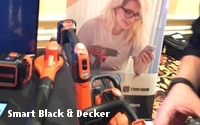 Many major companies are gradually migrating their
businesses to The Internet of Things.
Many major companies are gradually migrating their
businesses to The Internet of Things.
Some of these are a bit subtle while others are more blatant.
And the IoT move is for good reason.
With so many connected devices, from
smart watches to fitness trackers, smart appliances, connected thermostats, smart lighting and new types of connected objects being introduced on a regular basis, every consumer will be affected.
And this is aside from all the industrial IoT applications, such as connected buildings that drive cost savings to the bottom line.
But marketing will live in the consumer aspects of the
IoT and consumers are seeing more and more of it every day.
For example, TV viewers of this year’s Super Bowl will be treated to a commercial for Amazon’s Alexa, the digital
assistant that controls its Echo home automation device.
They’ve already seen plenty of commercials and ads for other smart devices and they will be seeing more.
Here are but a
handful of example of companies that are moving into the land of IoT:
- With sales of iPhones, iPads and Macs slowing, Apple has its eye on its Internet of Things control system called
HomeKit.
- Google just received a patent for delivering parcels by drone.
- Well-known lock maker Schlage has branched out into smart locks.
- Black & Decker tools now come
with technology that allows monitoring remotely via smartphone.
- GE sells smart lightbulbs.
- Andersen Windows is marketing its VeriLock technology so a homeowner can tell if a window
or door is open, locked or unlocked.
- Sony recently acquired a semiconductor company to help grows its Internet of Things business.
- Tag Heuer is focusing its watch business on smart
timepieces, even partnering with a football league to boost its marketing efforts there.
And it’s not just that well-known companies are moving into IoT, consumers are heading in
the same direction.
For example, the number of wearable devices bought in the U.K. doubled in a year.
Consumers already own many smart devices in their homes, led by smoke detectors,
smart thermostats and smart home systems.
And within four years, more than 225 million connected wearables devices are expected to ship globally.
The Internet of Things wave is not
only around the corner. It is here.